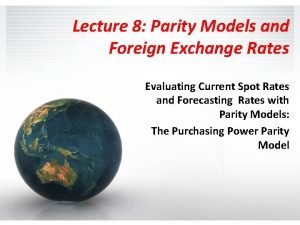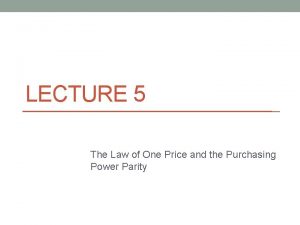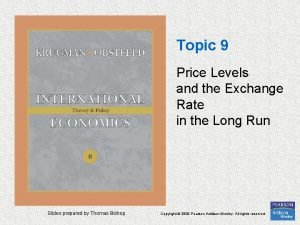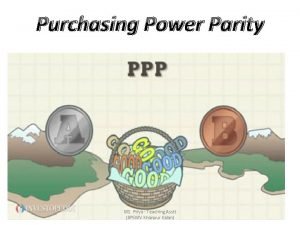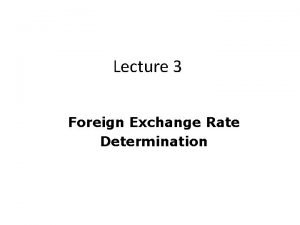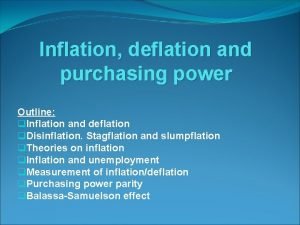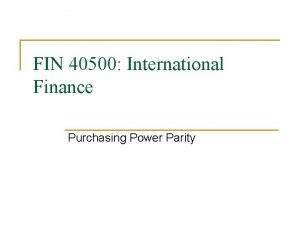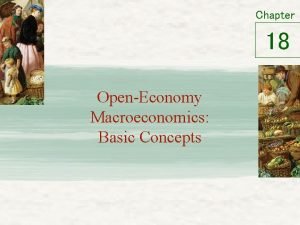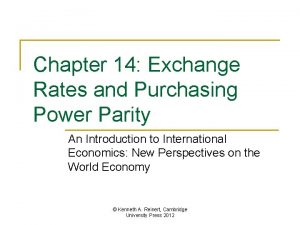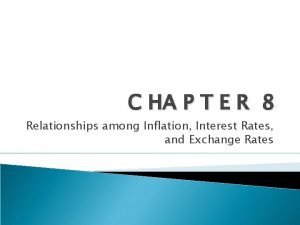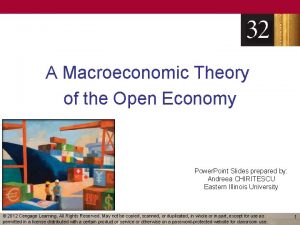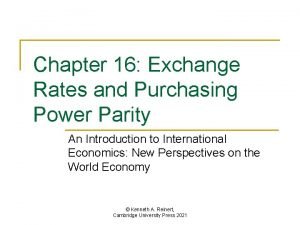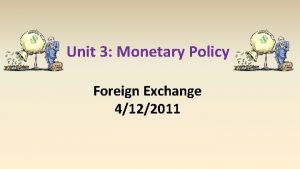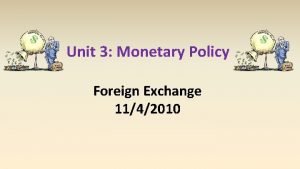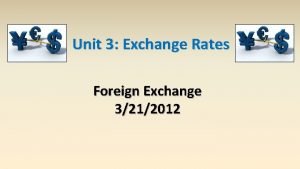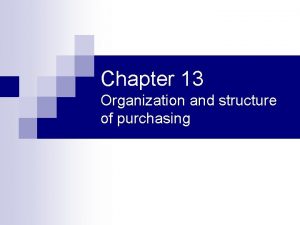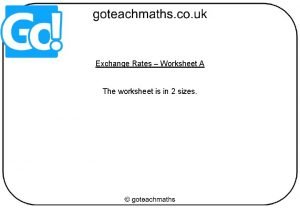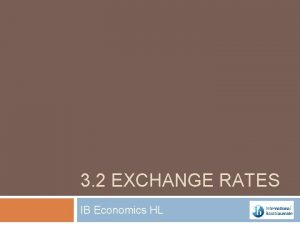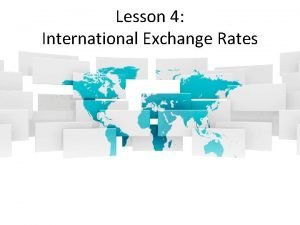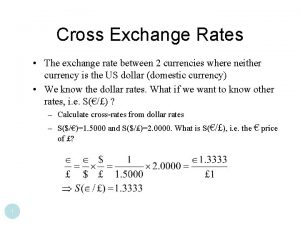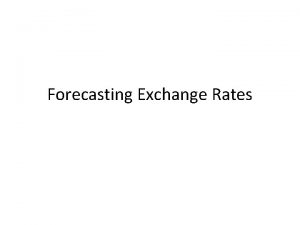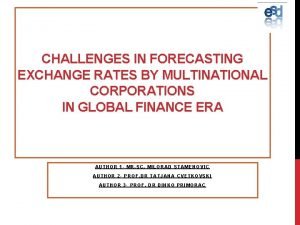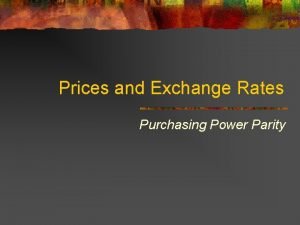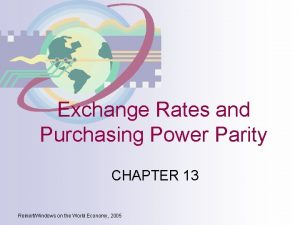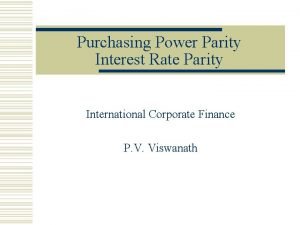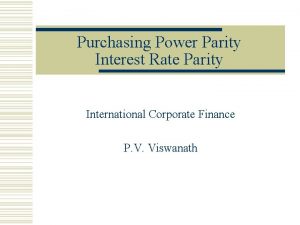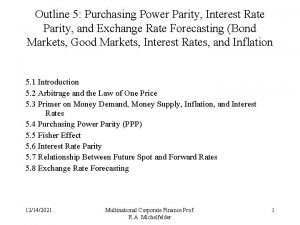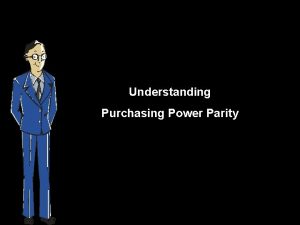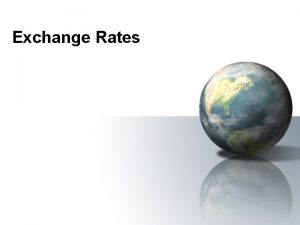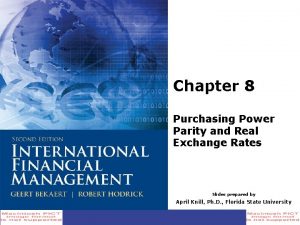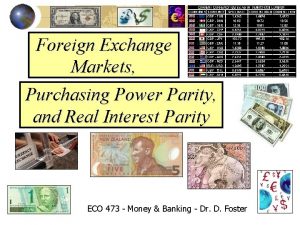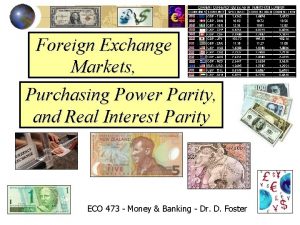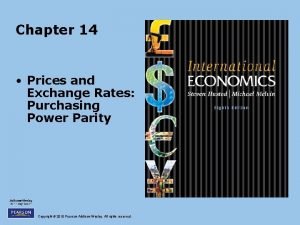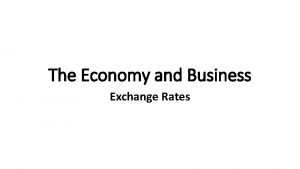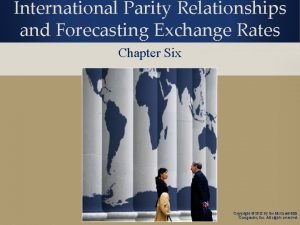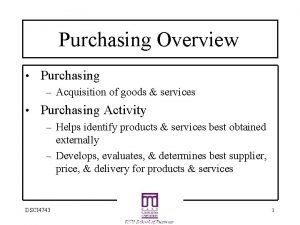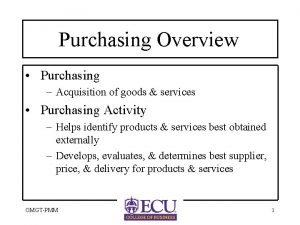Chapter 16 Exchange Rates and Purchasing Power Parity






























- Slides: 30

Chapter 16: Exchange Rates and Purchasing Power Parity An Introduction to International Economics: New Perspectives on the World Economy © Kenneth A. Reinert, Cambridge University Press 2021

Analytical Elements n n n Countries Currencies Financial assets © Kenneth A. Reinert, Cambridge University Press 2021

Introduction n Exchange rates matter in many different ways to many different constituencies in the world economy Much of this section on international finance will be directly or indirectly concerned with exchange rates Two important exchange rate definitions: q q n A first model of exchange rate determination q n Nominal exchange rate Real exchange rate The purchasing power parity model (PPP model) Relationship of exchange rates and trade flows: q q Spot rates vs forward rates Exchange rate exposure Price level Monetary approach to exchanger rate determination © Kenneth A. Reinert, Cambridge University Press 2021

The Nominal Exchange Rate n Relative price of two currencies q Often expressed as number of units of local or home currency required to buy a unit of foreign currency n We will take Mexico (peso) as our home country and United States (dollar) as our foreign country Nominal or currency exchange rate (e) is defined as n Or n © Kenneth A. Reinert, Cambridge University Press 2021

Table 16. 1 Nominal exchange rates, February 17, 2016 (per US dollar) Source: www. economist. com © Kenneth A. Reinert, Cambridge University Press 2021

The Nominal Exchange Rate n n n If e increases the value of the peso (home currency) falls If e decreases the value of the peso (home currency) rises Since e and the value of the peso are inversely related, e is often graphed as its inverse which is equal to the value of the peso This is done in Figure 16. 1 The value of the It is important when looking at peso scale exchange rate data to be aware of which country is the home country © Kenneth A. Reinert, Cambridge University Press 2021

Figure 16. 2 The yen/dollar nominal exchange rate, 1960– 2016 © Kenneth A. Reinert, Cambridge University Press 2021

The Real Exchange Rate n n n Nominal exchange rate: The rate at which two countries’ currencies trade against each other. Real exchange rate: The rate at which two countries’ goods and services trade against each other. The real exchange rate makes use of the price levels in the two countries under consideration © Kenneth A. Reinert, Cambridge University Press 2021

The Real Exchange Rate n n Measures the rate at which two countries’ goods trade against each other Makes use of the price levels in the two countries under consideration q q PM—overall price level in Mexico (the home country) PUS—overall price level in the United States (the foreign country) © Kenneth A. Reinert, Cambridge University Press 2021

Table 16. 2: Changes in the Real Exchange Rate Change Intuition Effect in “re” equation PUS increases US goods increase in price. Therefore, it takes more Mexican goods to buy a unit of US goods. The real value of the peso has fallen. Because it is in the numerator, the increase in PUS increases the value of re. PM increases Mexican goods increase in price. Therefore, it takes fewer Mexican goods to buy a unit of US goods. The real value of the peso has risen. Because it is in the denominator, the increase in PM decreases the value of re. e increases It takes more Mexican pesos to buy US dollars. The real value of the peso has fallen. The increase in increases the value of re. © Kenneth A. Reinert, Cambridge University Press 2021

Real Effective Exchange Rate n Just as there is an effective exchange rate for the nominal exchange rate, so is there a real effective exchange rate (REER) for the real exchange rate © Kenneth A. Reinert, Cambridge University Press 2021

Purchasing Power Parity n n n Begins with the hypothesis that the nominal exchange rate will adjust so that the purchasing power of a currency will be the same in every country The purchasing power of a currency in a given country is inversely related to price level in that country Therefore, the PPP hypothesis can be stated as © Kenneth A. Reinert, Cambridge University Press 2021

Purchasing Power Parity n The PPP equation can be rearranged as n It can also be arranged as n Here we see that the PPP model is a special case of the real exchange rate being fixed at unity q In reality, though, real exchange rates do change © Kenneth A. Reinert, Cambridge University Press 2021

Interpreting Purchasing Power Parity n The PPP assumes that all goods entering into country price levels are traded q n n In reality, many goods are non-traded Currency trading is also dominated by financial asset considerations rather than trade considerations The PPP is useful to get a sense of the long-term tendency towards which nominal exchange rates move absent other changes © Kenneth A. Reinert, Cambridge University Press 2021

Exchange Rates and Trade Flows n n Changes in e have an impact on trade flows Consider the case of Mexico’s imports and exports q q World prices (PW) are typically in US dollar terms Mexican prices (PM) are in peso terms Relationship between the peso and world prices of Mexico’s import (Z) goods can be expressed as Relationship between the peso and dollar prices of Mexico’s exported (E) goods can be expressed as © Kenneth A. Reinert, Cambridge University Press 2021

Exchange Rates and Trade Flows n Suppose e were to increase (the value of the peso falls) q q n Movement down the scale increases the peso price of the imported good in Mexico Import demand consequently decreases Suppose e were to decrease (the value of the peso rises) q q Movement up the scale decreases the peso price of the imported good in Mexico Import demand consequently Figure 16. 3: The Value of the Peso and increases Mexico’s Trade Deficit © Kenneth A. Reinert, Cambridge University Press 2021

Exchange Rates and Trade Flows n Suppose e were to increase (the value of the peso falls) q q n Movement down the increases the peso price of the export good in Mexico Export supply in Mexico consequently increases Suppose e were to decrease (the value of the peso rises) q q Movement up the inverse scale decreases the peso price of exports in Mexico Export supply consequently decreases Figure 16. 3: The Value of the Peso and Mexico’s Trade Deficit © Kenneth A. Reinert, Cambridge University Press 2021

Exchange Rates and Trade Flows n As seen in Figure 16. 3, the relationship between exchange rates and trade flows is important in its own right as a link between the international trade and international finance windows of the world economy © Kenneth A. Reinert, Cambridge University Press 2021

Hedging and Foreign Exchange Derivatives n n Firms enter foreign markets via contracting and foreign direct investment If the sales from any of these market-entry strategies are not denominated in the currencies of the firms’ home-base countries, issues of exchange rate exposure arise © Kenneth A. Reinert, Cambridge University Press 2021

Hedging and Foreign Exchange Derivatives n Suppose that the €/US$ exchange rate is currently at a value of 1. 00. Suppose also that a US firm is expecting euro revenues of € 1. 0 million. q n Given the current exchange rate, known as a spot rate, the US firm might be expecting dollar revenues of US$1. 0 million. Suppose, however, that the euro weakens, and the spot rate moves to = 1. 25 (a dollar value of the euro of $0. 80). q It now takes more euros to purchase a dollar, and the dollar revenues shrink to $800, 000 © Kenneth A. Reinert, Cambridge University Press 2021

Foreign Exchange Derivatives n Table 16. 3 distinguishes among four types of foreign exchange derivatives q q n Forward contracts Foreign exchange swaps Currency swaps Options Figure 16. 4 plots these types of derivatives using data from the Bank of International Settlements © Kenneth A. Reinert, Cambridge University Press 2021

Table 16. 3: Foreign Exchange Derivatives Derivative type Explanation Forward contracts Two parties agree on a foreign exchange transaction to take place at a specified, future date. Foreign exchange swaps Two parties exchange currencies for a specified length of time after which the currency exchange is reversed. Currency swaps Two parties exchange interest payments in different currencies for a specified period of time and then exchange principals at a specified maturity date. Options A party purchases the right to exchange one currency for another at a specified, future date and at a specified rate. © Kenneth A. Reinert, Cambridge University Press 2021

Figure 16. 4: Foreign Exchange Derivatives Source: Bank for International Settlements © Kenneth A. Reinert, Cambridge University Press 2021

Hedging n Foreign exchange derivates are financial instruments that have the effect of “locking in” a forward exchange rate q n How can they play a role in hedging exchange rate exposure? Consider this using the forward rate q q q If the forward rate of the euro (€/US$) is the same as the spot rate, the euro is said to be “flat” If the forward rate of the euro is above the spot rate, the euro is said to be at a “forward discount” Finally, if the forward rate of the euro is below the spot rate, the euro is said to be at a “forward premium” © Kenneth A. Reinert, Cambridge University Press 2021

Hedging n n n Suppose that we begin with the exchange rate (€/US$) being 1. 00 and that a US firm is expecting euro revenues of € 1. 0 million in six month’s time Suppose that the euro is at a six-month forward discount of 1. 11. The US firm could take out a forward contract and, at that future time, convert the euro revenue into $900, 900 of dollar revenue. © Kenneth A. Reinert, Cambridge University Press 2021

Hedging n n Would this be a smart move? If the firm knew with certainty that the future spot rate were to be 1. 25, it would be. q n If the future spot rate were actually to be below 1. 11, though, it would not be. q n With the forward contract, the firm would earn $900, 900 rather than $800, 000. The firm could have earned more than $900, 900 without the forward contract Thus hedging exchange rate exposure requires that firms have expectations or forecasts of future spot rates © Kenneth A. Reinert, Cambridge University Press 2021

Appendix 16. 1: Price Levels and the PPP Model n n n Price level Assumption: Income Y is equal to both the nominal gross domestic product and the nominal gross national income Any change in Y can be separated into the part due to a change in the number of goods and services (y) and the part due to a change in the prices of goods and services (P) This measure of the price level is known as the GDP price deflator. This is the price level measure used in this chapter. © Kenneth A. Reinert, Cambridge University Press 2021

Appendix 16. 1: Price Levels and the PPP Model n © Kenneth A. Reinert, Cambridge University Press 2021

Appendix 16. 2: The Monetary Approach to Exchange Rate n There is an approach to monetary theory known as Determination n monetarism This concerns the quantity theory of money based on the equation of exchange Here, M is the money stock, V is the velocity of money, P is the overall price level and y is real GDP Monetarists add two assumptions to this equation q q V is stable (slowly changing) y is determined by the supply side (slowly changing) © Kenneth A. Reinert, Cambridge University Press 2021

Appendix 16. 2: The Monetary Approach to Exchange Rate n This long-run monetarist relationship can be Determination combined with the long-run purchasing power parity (PPP) relationship n This represents the monetary approach to exchange rate determination q e is determined primarily by the money stock ratio, secondarily real output and velocity ratios © Kenneth A. Reinert, Cambridge University Press 2021
 Power parity theory
Power parity theory Law of one price exchange rate
Law of one price exchange rate Relative ppp
Relative ppp Purchasing power parity
Purchasing power parity Interest rate parity theorem
Interest rate parity theorem Negative effects of inflation
Negative effects of inflation Calculating purchasing power parity
Calculating purchasing power parity Purchasing power parity theory
Purchasing power parity theory How to calculate purchasing power parity
How to calculate purchasing power parity Fisher effect
Fisher effect How to calculate purchasing power parity
How to calculate purchasing power parity Exchange rate equation
Exchange rate equation Purchasing power parity theory
Purchasing power parity theory Ppp dollars meaning
Ppp dollars meaning Interest parity
Interest parity Centralized purchasing and decentralized purchasing
Centralized purchasing and decentralized purchasing Purchasing purchasing
Purchasing purchasing Unit rate
Unit rate Equivalent ratios guided notes
Equivalent ratios guided notes Ratios rates and unit rates
Ratios rates and unit rates Ratios rates and unit rates
Ratios rates and unit rates Chapter 3 your purchasing power
Chapter 3 your purchasing power Exchange rate maths literacy
Exchange rate maths literacy Foreign exchange worksheet
Foreign exchange worksheet Overvalued currency
Overvalued currency Exchange rates lesson
Exchange rates lesson Cross exchange
Cross exchange Fundamental forecasting of exchange rates
Fundamental forecasting of exchange rates Currency forcast
Currency forcast Market-based forecasting of exchange rates
Market-based forecasting of exchange rates Qqnqq
Qqnqq
